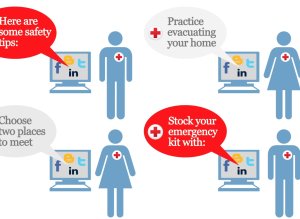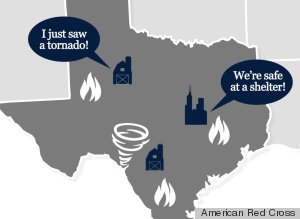
Nearly four years ago, as Haiti struggled to overcome an earthquake that killed tens of thousands, humanitarian response agencies -- the Red Cross among them -- swung into action.
Here in the United States, my social media team swung into action watching the social space for mentions of the quake. We quickly learned that we had a disaster on our hands that would forever change the way the Red Cross used social media during emergencies.
I remember walking out of my office one afternoon shortly after the quake to find a pretty distressed group of people staffing our social media channels. They were receiving social media messages from members of the Haitian diaspora community requesting help for families in the affected areas. In some cases, people were providing the exact location of relatives trapped in collapsed buildings. Our team tried to move that information to people on the ground that could help. But it was tough to see that level of need and no formal way to direct the requests.
It was a wakeup call, to say the least. It woke us all up to the fact that social community had a lot to offer the response community if we opened up the channels and listened. The people closest to the disaster -- the ones standing in the rubble of their own communities -- could tell us which areas were hardest hit and what people needed far faster than anyone else.
It also woke us up to the public expectation that response agencies must listen and render help digitally just as we would in the physical world. Public opinion research conducted by the Red Cross over the past couple of years has shown that social media is the fourth most popular way for people to get emergency information, still behind TV and radio but quickly moving up the list. We also know through that research that public expects help in under an hour if they post a need on social media.
It was that experience with the Haiti earthquake that led the Red Cross to establish a much more robust social listening program. In 2012, the Red Cross opened its first Digital Operations Center in Washington, D.C. It was the first social listening center dedicated to humanitarian response. It gives the Red Cross the ability to scan the social space for situational awareness and opportunities to provide information about how to get Red Cross assistance. The center also sits just a few feet away from our operations leadership, so we can pass information to them quickly.
Superstorm Sandy proved to be a pivotal experience in the use of social data to help disaster survivors. The Digital Operations Center team of staff and volunteers collected more than 2.5 million individual social media concerning the disasters. We isolated nearly 300 of them that showed trends or actionable information and that passed the information to our operations teams. In nearly 90 instances, that information prompted a change in our services.

More recently in the Moore, Okla., tornadoes, we collected more than 800,000 pieces of social data. Some of that led us to pockets of damage in isolated, rural areas.
We were able to send help to communities no one knew had been affected.
We've now expanded this capability with a second Digital Operations Center, recently opened at our chapter in Dallas. The Red Cross is also expanding its digital volunteer program and training so more people can help us analyze the data so vital to disaster response. All of this has been generously funded by Dell and will expand our capability to listen and engage in the social space during emergencies.
It's clear that the American public expects the same level of compassion and action in the digital space that they see the Red Cross delivering on the ground in affected communities. The launch of the Dallas Digital Operations Center was an obvious next step to enhance our reach in the social space and provide the public a seat at the table when we're making disaster response decisions. Most importantly, it gives us more chances to listen, engage and give hope in a whole new way.
Here's a video to show you how it all works:
If you're interested in supporting social engagement activities in your area, please contact your local chapter to learn more.
Cisco partners with American Red Cross to respond to disasters with employee giving campaigns and volunteers who provide food, water, shelter, and relief services to people affected by natural disasters. For more information about about Cisco’s focus area of critical human needs and disaster relief, please visit: http://csr.cisco.com/pages/critical-human-needs